Kingdom of Scotland
Kingdom of Scotland | |||||||||
|---|---|---|---|---|---|---|---|---|---|
| 843–1707 | |||||||||
| Motto: [Nemo me impune lacessit] Error: {{Lang}}: text has italic markup (help) (Latin) "No one provokes me with impunity" "Cha togar m'fhearg gun dioladh" (Gaelic) "Wha daur meddle wi me?" (Scots) | |||||||||
 Location of Kingdom of Scotland (orange) in Europe (white) | |||||||||
| Capital | Edinburgh¹ | ||||||||
| Common languages | Scottish Gaelic, Scots | ||||||||
| Government | Monarchy | ||||||||
| Monarch | |||||||||
• 843-860 | Kenneth I | ||||||||
• 1587–1625 | James VI | ||||||||
• 1702-1714 | Anne | ||||||||
| Legislature | Parliament of Scotland | ||||||||
| History | |||||||||
• United | 843 | ||||||||
• Lothian and Strathclyde incorporated | 1124 (confirmed Treaty of York, 1237) | ||||||||
• Galloway incorporated | 1234/5 | ||||||||
| 1266 (Treaty of Perth) | |||||||||
| 1472 | |||||||||
| May 1 1707 | |||||||||
| Currency | Pound Scots (Pund) | ||||||||
| ISO 3166 code | GB-SCT | ||||||||
| |||||||||
¹ By the early modern era established at Edinburgh, and before that Scone & various. | |||||||||
- This article is about the historical state called the Kingdom of Scotland (843-1707). For information about the modern country, see the main article: Scotland.
The Kingdom of Scotland (Scottish Gaelic: Rìoghachd na h-Alba, Scots: Kinrick o Scotland) was a state in northwest Europe which existed from 843 until 1707. It occupied the northern third of the island of Great Britain and shared a land border to the south with the Kingdom of England, with which it was united to form a unified Kingdom of Great Britain, under the terms of the Acts of Union, in 1707. Since 1482, following England's taking control of the coastal town of Berwick, the territory of the Kingdom of Scotland corresponded to that of modern day Scotland's. It was bounded by the North Sea to the east, the Atlantic Ocean to the north and west, and the North Channel and Irish Sea to the southwest. Apart from the mainland, the Kingdom of Scotland consisted of over 790 islands.
Edinburgh, the country's largest town, was preceded by the towns of Scone, Dunfermline and Stirling, as the country's capital. The population of the Kingdom of Scotland in 1700 was approximately 1.1 million.
History
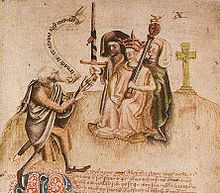
- Main article: History of Scotland
The Kingdom of Scotland was united in 843, by King Cináed I of Scotland. Over the next 850 years it developed its own legal and educational systems- which still exist to this day- as well as a separate monetary and measures systems. At first the kingdom was confined to the area north of the Rivers Forth and Clyde. Southwest Scotland remained under the control of the Strathclyde Britons. Southeast Scotland was under the control from around 638 of the proto-English kingdom of Bernicia, then of the Kingdom of Northumbria. This part of Scotland was contested from the time of Constantine II and finally fell into Scottish hands in 1018, when Máel Coluim II pushed the border as far south as the River Tweed. This remains the south-eastern border to this day (except around Berwick-upon-Tweed).
In 1263 Scotland and Norway fought the Battle of Largs for control over the Western Isles. The battle was indecisive, but the campaign proved once and for all that the Norse were unable to retain effective control over the distant Isles. In 1266 the Norwegian king Magnus VI of Norway signed the Treaty of Perth, which acknowledged Scottish suzerainty over the islands. Despite the treaty the practical independence of the Lord of the Isles continued.
The Auld Alliance was an important alliance between Scotland and France. It dates from the treaty signed by John Balliol and Philip IV of France, in 1295 It played a varying but sometimes large role in Franco-Scottish (and English affairs), until 1560. In 1512 under a treaty extending the Auld Alliance, all nationals of Scotland and France also became nationals of each other's countries, a status not repealed in France until 1903 and which may never have been repealed in Scotland.

Scotland's kings placed great importance on the strategic stronghold of Stirling, leading to the battles of Stirling Bridge and Bannockburn during the Wars of Scottish Independence, when the historic figures of William Wallace and Robert the Bruce emerged. In 1320 a remonstrance to the Pope from the nobles of Scotland (the Declaration of Arbroath) finally convinced Pope John XXII to overturn the earlier excommunication and nullify the various acts of submission by Scottish kings to English ones so that Scotland's sovereignty could be recognised by the major European dynasties.
In 1468 the last great acquisition of Scottish territory occurred when James III married Margaret of Denmark, receiving the Orkney Islands and the Shetland Islands in payment of her dowry and in 1493 his son, James IV, successfully ended the quasi-independent rule of the Lord of the Isles, bringing the Western Isles under effective Royal control for the first time.
James IV's reign is often considered to be a period of cultural flourishing, and it was around this period that the European Renaissance began to infiltrate Scotland. Scotland advanced markedly in educational terms during the fifteenth century with the founding of the University of St Andrews in 1413, the University of Glasgow in 1450 and the University of Aberdeen in 1494, and with the passing of the Education Act 1496.
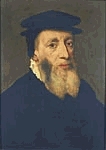
During the 16th century, Scotland underwent a Protestant Reformation. In the earlier part of the century, the teachings of first Martin Luther and then John Calvin began to influence Scotland. The execution of a number of Protestant preachers, most notably the Lutheran influenced Patrick Hamilton in 1527 and later the Calvinist George Wishart in 1546 who were burnt at the stake in St. Andrews by Cardinal Beaton for heresy, did nothing to stem the growth of these ideas. Beaton was assassinated shortly after the execution of George Wishart.
The eventual Reformation of the Scottish Church, was carried out by Parliament from 1560 (during the minority of Mary Queen of Scots) when most Scots adopted Calvinism. The most influential figure was that of John Knox, who had been a disciple of both John Calvin and George Wishart. Roman Catholicism was not totally eliminated, and remained strong particularly in parts of the highlands.
In 1603 James VI King of Scots, became King James I of England thus Scotland entered into a personal union with England and Ireland. The seventeenth century saw a period of unrest in Scotland, religious Confrontation in Scotland with Charles I, who attempted to impose English-style prayer books on the Scottish church, led to the setting up of the National Covenant, and later to the Bishops' Wars, the Scottish Civil War and Wars of the Three Kingdoms. From 1651-1660 Scotland was occupied by a Cromwellian army under George Monck.
In 1689 the Dutch Prince William of Orange became William II, King of Scots. Whilst the "Glorious Revolution" was primarily an English event, it had a great impact on Scottish history. The Scottish Parliament offered the Crown of Scotland which William accepted under the conditions of the Claim of Right (an important document in the evolution of the rule of law and the rights of subjects similar to the English Bill of Rights).
Many Scots supported William, but many (particularly in the Highlands) remained sympathetic to James VII. His cause, which became known as Jacobitism from the Latin 'Jacobus', meaning 'James', spawned a series of uprisings. An initial Jacobite rising under John Graham, 1st Viscount Dundee (Bonnie Dundee) defeated William's forces at the Battle of Killiecrankie in 1689, but Dundee was slain in the fighting, and the Jacobite army was soon defeated at the Battle of Dunkeld. The complete defeat of James VII in Ireland by William at the Battle of the Boyne in 1690, followed by the Massacre of Glencoe in 1692, succeeded in finally persuading those remaining Highland Clan Chieftains reluctant to pledge allegiance to William to reconsider their positions.
The late 17th century was economically difficult for Scotland. The bad harvests of the seven ill years or lean years in the 1690s led to severe famine and depopulation. English protectionism kept Scots traders out of the new colonies, and English foreign policy disrupted trade with France. As a result many Scots emigrated to Ulster (the Ulster-Scots). The Parliament of Scotland of 1695 enacted a number of remedies for the desperate economic situation, including setting up the Bank of Scotland. The Act for the Settling of Schools established a parish-based system of public education throughout Scotland. The Company of Scotland received a charter to raise capital through public subscription to trade with Africa and the Indies. By the early eighteenth century, Scotland was a kingdom in crisis. Her economy had been severely weakened by a series of major harvest failures beginning. The lean years of the 1690s were compounded by the catastrophic failure of the Darien Scheme, deliberately sabotaged by the combined efforts of the English East India Company, the international financial markets at Amsterdam and King William, it is estimated that almost 25% of Scotland's total liquid capital was lost in the Darien venture.
Government

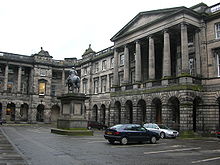
The political structure of Scotland was historically complex. During most of the existence of the Kingdom of the Scots, however, a single monarch, or High King was recognized. Under the suzerainty of the High King, there were chieftains, and petty kings, and offices filled through selection by an assembly under a system known as tanistry, which combined an hereditary element with the consent of those ruled. Usually, the candidate was nominated by the current office holder on the approach of death, and his heir-elect was known as the tanist, from the Scottish Gaelic tànaiste.
After Macbeth was overthrown by Máel Coluim III in 1057, and during the reign of King David I, the influence of Norman settlers in Scotland saw primogeniture adopted as the means of succession in Scotland, as in much of Western Europe, and witnessed the development of a 'hybrid kingdom', one part of which was governed by a mixture of a feudal government, the other following traditional Celtic customary law. These early assemblies cannot be considered 'parliaments' in the later sense of the word.
Originally, Scots owed their allegiance primarily to their Clan chieftain, or to the laird, thus the High King consistently had to keep them of favorable disposition, or else risk armed conflict.
The Parliament of Scotland, was the legislature. The members were collectively referred to as the "Three Estates" for nearly all of the parliament's history. It was composed of the first estate of prelates (bishops and abbots), the second estate of lords (dukes, earls, parliamentary peers and lay tenants-in-chief), and the third estate of burgh commissioners. From the sixteenth century, the second estate was reorganised by the selection of shire commissioners. This has been argued to have created a 'fourth estate', while a 'fifth estate', composed of royal office holders, has also been identified. These identifications remain highly controversial among parliamentary historians. Regardless of these distinctions and controversial demarcation lines with the body, the term used for the assembled members continued to be 'the Three Estates'. The Parliament was a unicameral assembly.
The Scottish parliament is first found on record during the early thirteenth century, and the first meeting for which reliable evidence survives (referred to, like the English parliament, as a colloquium in the surviving Latin records), was at Kirkliston, in 1235, during the reign of Alexander II.
The two most powerful periods of the Scottish Parliament's existence can be defined as 1639-51 and 1689-1707. During the era of Covenanting control, the Scottish Parliament emerged as a mature political and institutional forum, and was one of the most powerful assemblies in Europe. Drawing on the Scottish Constitutional Settlement of 1640-41, a programme of constitutional reform was renewed from 1689, when it passed the Claim of Right, onwards. The last session sat on 25th May, 1707, after which the Parliament of Great Britain assumed responsibility for Scottish affairs, under the terms of the Acts of Union, with effect from 1st May, 1707.
Union with England
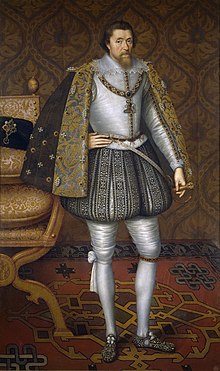
Scotland's monarch, James VI, King of Scots, succeeded to the throne of the Kingdom of England in 1603, becoming King James I of England, after the death of Queen Elizabeth I of England. This was merely a personal union: the two nations shared a head of state but retained their own separate parliaments and administration.
While there had been three earlier attempts (in 1606, 1667 and 1689) to politically unite the two countries by Acts of Parliament, these were the first Acts which had the will of both political establishments behind them, albeit for rather different reasons. In the English case, the purpose was to establish the Royal succession along Protestant lines in the same manner as provided for by the English Act of Settlement 1701 rather than that of the Scottish Act of Security. In the Scottish case, the purpose was partly to use English subsidies to recover from the financial problems caused by the failure of the Darién scheme and partly to remove English trade sanctions put in place through the Alien Act to force the Scots Parliament into compliance with the Act of Settlement.
A major feature of English politics from 1702 to 1707 was the necessity of securing the Hanoverian Succession. The death of King William in 1702 resulted in the succession of Queen Anne to the crowns of England and Scotland. Anne's last surviving child had died in 1700 and the English Act of Settlement had passed the English Succession over to the Protestant House of Hanover. Since it was unthinkable that Scotland and England should again have separate monarchs, the securing of the Hanoverian Succession in Scotland became the primary objective in English strategic thinking towards Scotland. By 1703 the Anglo-Scottish dynastic union, the Union of the Crowns, was in crisis. The Scottish Parliament was pursuing both an independent dynastic and foreign policy and the Scottish Act of Security allowed for the Scottish Parliament to choose a different monarch to succeed to the Scottish crown from that of England, if it so wished. Many in Scotland saw this as a desirable position given that the English Parliament had executed King Charles I during the English Civil War without any reference to the Scottish Parliament, despite Charles also being King of Scots. This meant that the Act allowed for the Scottish Parliament to initiate an independent foreign policy during an era of major European warfare like the War of the Spanish Succession and the Great Northern War. From the English political perspective, this opened up the possibilities of the restoration of a Jacobite on the Scottish throne or a Scottish trading and/or military alliance with another power in Europe like France or the Dutch Republic. Such an alignment could result in attacks from Scotland, Ireland and the continent and compromise English interests abroad. Hence the Scottish `problem' had to be neutralised and the Hanoverian Succession secured.
The Kingdom of Scotland ceased to exist on 1 May 1707, following passage of the Acts of Union, which merged Scotland with England thereby creating the Kingdom of Great Britain. The Acts incorporated provisions for Scotland to send representative peers from the Peerage of Scotland to sit in the House of Lords. It guaranteed that the Church of Scotland would remain the established church in Scotland, that the Court of Session would "remain in all time coming within Scotland" and that Scots law would "remain in the same force as before". Other provisions included the restatement of the Act of Settlement 1701 and the ban on Roman Catholics from taking the throne. It also created a customs union and monetary union. The Act provided that any "laws and statutes" that were "contrary to or inconsistent with the terms" of the Act would "cease and become void."
Flag
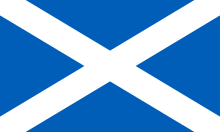

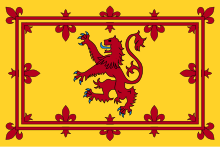
The flag of Scotland features a white saltire, a crux decussate (X-shaped cross) representing the cross of the Christian martyr Saint Andrew, the patron saint of Scotland, on a blue field. It is named the Saltire or the Saint Andrew's Cross. In heraldic language, it may be blazoned Azure, a saltire argent. The flag of Scotland is one of the oldest flags in the world, traditionally dating back to the 9th century, and is the oldest national flag still in modern use.
Following the Union of the Crowns in 1603, King James I & VI commissioned new designs for a banner incorporating the flags of the Kingdom of Scotland and Kingdom of England. In 1606, a Union Flag was commissioned, with separate versions being used in each independent kingdom. The 'Scotch' version, showing the Cross of Saint Andrew overlying the Cross of Saint George, saw limited use in Scotland from 1606 to 1707. The reverse was the case in England, with the 'English' version ultimately being adopted as the flag of the unified Kingdom of Great Britain from 1707.
The Royal Standard of Scotland, also known as the Lion Rampant, was the flag of the King of Scots, a banner of the Royal Coat of Arms of Scotland. It remains the personal banner of the monarch and use of this flag is restricted under the Act of the Parliament of Scotland 1672 cap. 47 and 30 & 31 Vict. cap. 17. Its correct use is now restricted to only a few Great Officers who officially represent The Sovereign, and flies above Royal Residences in Scotland when the monarch is not in residence.
References
See also
- Origins of the Kingdom of Alba
- List of monarchs of Scotland
- List of monarchs of Scotland in Gaelic
- Scottish monarchs family tree
- Royal Consorts of Scotland
- Parliament of Scotland
- Royal Scottish Navy
- Honours of Scotland
- Linlithgow Palace
- Falkland Palace
- Bank of Scotland
- Scottish Term Day
- Pound Scots
- Obsolete Scottish units of measurement
| Kingdom of Scotland c843-1707 |
Succeeded by: Kingdom of Great Britain 1707-1801 |
Succeeded by: United Kingdom of Great Britain and Ireland 1801-1921 |
Succeeded by: United Kingdom of Great Britain and Northern Ireland since 1921 |


